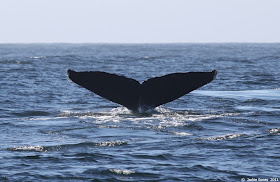Here's an update to "The journey" post from 19 June 2012. Thanks to the help of a few people, we now have a possible translation for the characters on the float and a possible barnacle identification.
First, I'd like to acknowledge everyone who has helped with this effort. I can only share the information below because of their generosity, time, and expertise. S. Gilbert contacted me and began the translation process. The Roberts family — Luke, Yachiyo, and May — then assisted with interpreting the characters and identifying the possible manufacturer of the float. Jim Carlton provided feedback on the identity of the barnacle.
Below is another view of the Asian characters. The photo has been flipped, because I didn't know the correct orientation when I first posted the photo! The image brightness/contrast has been adjusted to make it easier to see the raised characters. I've also circled the characters. I'm sure that #2-5 are characters. I'm not 100% certain about #1, but after looking at the float I think it could be a character, but it might not be possible to identify it at this time.
And here is a translation of characters #2-5:
Character #4 is the Japanese katakana symbol for the sound "fu". This symbol is only used in Japanese, identifying the origin of the float. "furooto" would be the Japanese way of writing the English word for float. It's possible that the last two syllables were represented but are no longer visible on the float.
Luke also located a manufacturing company, Sanshin Kako Co., Ltd., that began making polyethylene fishing floats in 1967. They now make dishes for schools and hospitals.
Jim Carlton suggested that the large barnacles on the float may be Megabalanus rosa (not M. californicus, as I originally proposed), a species found in the western Pacific. On 19 June, I wasn't certain about the identification, as the barnacles didn't seem quite right for M. californicus.
Unfortunately, the opercular plates are missing on all of these barnacles. The plates are important for barnacle identification. Jim is being sent some similar barnacles from the Japanese dock that washed up on Agate Beach in Oregon, so perhaps he'll have even more insight after reviewing those individuals.
Here's a close-up of one of the large pink barnacles — with small pelagic gooseneck barnacles and bryozoan (the lacy crust) growing on its shell. There were also two white barnacles on the float, similar to the pink barnacles in shape and structure but lacking the pink color.
Jim Carlton also pointed out that although we see objects with Asian characters washed ashore every year, they usually don't have Asian species growing on them. If this is Megabalanus rosa, and if the float originated in Japan, it's possible that this is debris from the March 2011 tsunami. If so, Salmon Creek Beach may be one of the southernmost locations along the North American coast from which tsunami-related debris has been reported to date.




















































